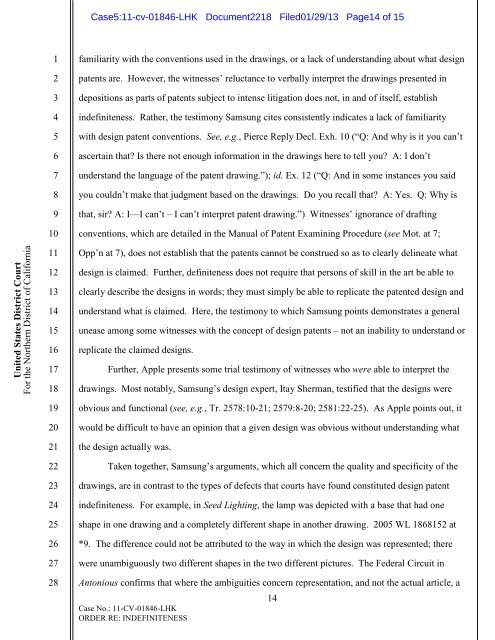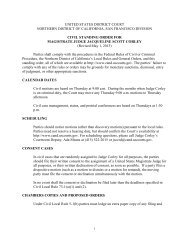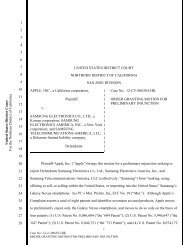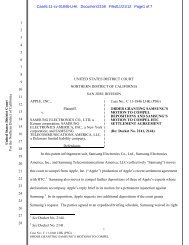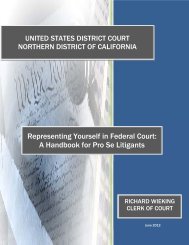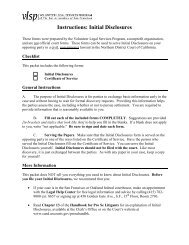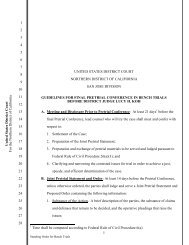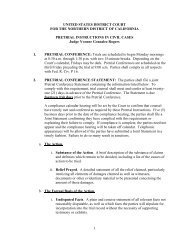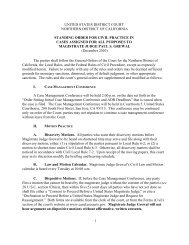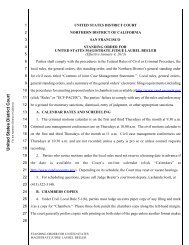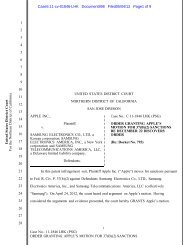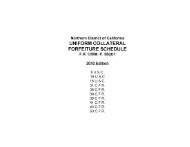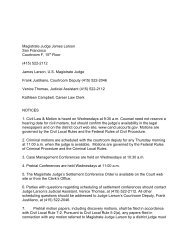Order re: Indefiniteness (.pdf, 126 KB) - United States District Court ...
Order re: Indefiniteness (.pdf, 126 KB) - United States District Court ...
Order re: Indefiniteness (.pdf, 126 KB) - United States District Court ...
You also want an ePaper? Increase the reach of your titles
YUMPU automatically turns print PDFs into web optimized ePapers that Google loves.
<strong>United</strong> <strong>States</strong> <strong>District</strong> <strong>Court</strong><br />
For the Northern <strong>District</strong> of California<br />
1<br />
2<br />
3<br />
4<br />
5<br />
6<br />
7<br />
8<br />
9<br />
10<br />
11<br />
12<br />
13<br />
14<br />
15<br />
16<br />
17<br />
18<br />
19<br />
20<br />
21<br />
22<br />
23<br />
24<br />
25<br />
26<br />
27<br />
28<br />
Case5:11-cv-01846-LHK Document2218 Filed01/29/13 Page14 of 15<br />
familiarity with the conventions used in the drawings, or a lack of understanding about what design<br />
patents a<strong>re</strong>. However, the witnesses’ <strong>re</strong>luctance to verbally interp<strong>re</strong>t the drawings p<strong>re</strong>sented in<br />
depositions as parts of patents subject to intense litigation does not, in and of itself, establish<br />
indefiniteness. Rather, the testimony Samsung cites consistently indicates a lack of familiarity<br />
with design patent conventions. See, e.g., Pierce Reply Decl. Exh. 10 (“Q: And why is it you can’t<br />
ascertain that? Is the<strong>re</strong> not enough information in the drawings he<strong>re</strong> to tell you? A: I don’t<br />
understand the language of the patent drawing.”); id. Ex. 12 (“Q: And in some instances you said<br />
you couldn’t make that judgment based on the drawings. Do you <strong>re</strong>call that? A: Yes. Q: Why is<br />
that, sir? A: I—I can’t – I can’t interp<strong>re</strong>t patent drawing.”) Witnesses’ ignorance of drafting<br />
conventions, which a<strong>re</strong> detailed in the Manual of Patent Examining Procedu<strong>re</strong> (see Mot. at 7;<br />
Opp’n at 7), does not establish that the patents cannot be construed so as to clearly delineate what<br />
design is claimed. Further, definiteness does not <strong>re</strong>qui<strong>re</strong> that persons of skill in the art be able to<br />
clearly describe the designs in words; they must simply be able to <strong>re</strong>plicate the patented design and<br />
understand what is claimed. He<strong>re</strong>, the testimony to which Samsung points demonstrates a general<br />
unease among some witnesses with the concept of design patents – not an inability to understand or<br />
<strong>re</strong>plicate the claimed designs.<br />
Further, Apple p<strong>re</strong>sents some trial testimony of witnesses who we<strong>re</strong> able to interp<strong>re</strong>t the<br />
drawings. Most notably, Samsung’s design expert, Itay Sherman, testified that the designs we<strong>re</strong><br />
obvious and functional (see, e.g., Tr. 2578:10-21; 2579:8-20; 2581:22-25). As Apple points out, it<br />
would be difficult to have an opinion that a given design was obvious without understanding what<br />
the design actually was.<br />
Taken together, Samsung’s arguments, which all concern the quality and specificity of the<br />
drawings, a<strong>re</strong> in contrast to the types of defects that courts have found constituted design patent<br />
indefiniteness. For example, in Seed Lighting, the lamp was depicted with a base that had one<br />
shape in one drawing and a completely diffe<strong>re</strong>nt shape in another drawing. 2005 WL 1868152 at<br />
*9. The diffe<strong>re</strong>nce could not be attributed to the way in which the design was <strong>re</strong>p<strong>re</strong>sented; the<strong>re</strong><br />
we<strong>re</strong> unambiguously two diffe<strong>re</strong>nt shapes in the two diffe<strong>re</strong>nt pictu<strong>re</strong>s. The Federal Circuit in<br />
Antonious confirms that whe<strong>re</strong> the ambiguities concern <strong>re</strong>p<strong>re</strong>sentation, and not the actual article, a<br />
Case No.: 11-CV-01846-LHK<br />
ORDER RE: INDEFINITENESS<br />
14


